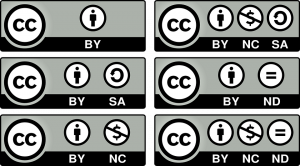Copyright and Creative Commons
This blog will give you a brief introduction to Creative Commons and how it relates to copyright. To understand how useful Creative Commons is for the ‘Teacher Librarian’ is its important to first understand copyright.
What is copyright?
Australian copyright law can simply be defined as the rights attributed to certain creative works such as text, artistic works, music, computer programs, sound recordings and films. The rights are granted automatically and exclusively to the copyright owner to reproduce the material, and the right to perform or show a work to the public. This means that there is no need to register a creative work. Once an artist produces it, they have the right to prevent others from reproducing or communicating their work without their permission or they may choose to sell these rights to someone else. (Smartcopying, 2018)
What is Creative Commons and how does it work?
Creative Commons is all about sharing the love for free with varying degrees of freedom! It’s the middle road between copyright which has “All Right Reserved” and public domain which has “No Right Reserved”. It was developed in 2001/02 by the ‘Centre for the Public Domain’ at the Duke Law School located at Duke University, North Carolina. This organisation provides free, easy to use copyright licences to suit the needs and conditions of the copyright owner. Currently, there are six different kinds of Creative Commons licence. (Center for the Study of the Public Domain, 2018). These six licences are explained in this simple video presentation by Kate Garner. (Ingenious Teacher Training, 2016)
Here are the SIX licences in pictographic form:
All CC licenses require that others who use your work in any way must give you credit the way you request, but not in a way that suggests you endorse them or their use. If they want to use your work without giving you credit or for endorsement purposes, they must get your permission first.
You let others copy, distribute, display, perform, and modify your work, as long as they distribute any modified work on the same terms. If they want to distribute modified works under other terms, they must get your permission first.
You let others copy, distribute, display, and perform only original copies of your work. If they want to modify your work, they must get your permission first.
You let others copy, distribute, display, perform, and (unless you have chosen NoDerivs) modify and use your work for any purpose other than commercially unless they get your permission first.
 PUBLIC DOMAIN. NO RIGHTS RESERVED.
PUBLIC DOMAIN. NO RIGHTS RESERVED.
(Creative Commons, 2018)
I hope you now have a better understanding of what Creative Commons is and how to use any text, artistic works, music, computer programs, sound recordings and film with a Creative Commons licence.
References
Copyright Agency. (2018). About Copyright. Retrieved from https://www.copyright.com.au/about-copyright/
Center for the Study of the Public Domain. (2018). https://law.duke.edu/cspd/about/
Creative Commons. (2018). https://creativecommons.org.au
Kate Garner. (Ingenious Teacher Training, 2016). https://youtu.be/cEjCeQH0fMs
Smartcopying, (2018). http://www.smartcopying.edu.au/copyright-guidelines/copyright—a-general-overview/1-1-what-is-copyright-




